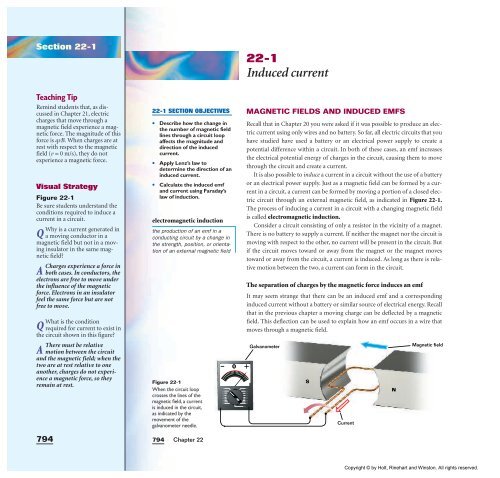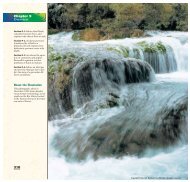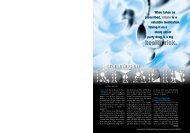Induction and Alternating Current with teacher's notes
Induction and Alternating Current with teacher's notes
Induction and Alternating Current with teacher's notes
Create successful ePaper yourself
Turn your PDF publications into a flip-book with our unique Google optimized e-Paper software.
Section 22-1<br />
Teaching Tip<br />
Remind students that, as discussed<br />
in Chapter 21, electric<br />
charges that move through a<br />
magnetic field experience a magnetic<br />
force. The magnitude of this<br />
force is qvB. When charges are at<br />
rest <strong>with</strong> respect to the magnetic<br />
field (v = 0 m/s), they do not<br />
experience a magnetic force.<br />
Visual Strategy<br />
Figure 22-1<br />
Be sure students underst<strong>and</strong> the<br />
conditions required to induce a<br />
current in a circuit.<br />
Why is a current generated in<br />
Q a moving conductor in a<br />
magnetic field but not in a moving<br />
insulator in the same magnetic<br />
field?<br />
Charges experience a force in<br />
A both cases. In conductors, the<br />
electrons are free to move under<br />
the influence of the magnetic<br />
force. Electrons in an insulator<br />
feel the same force but are not<br />
free to move.<br />
Q<br />
What is the condition<br />
required for current to exist in<br />
the circuit shown in this figure?<br />
There must be relative<br />
A motion between the circuit<br />
<strong>and</strong> the magnetic field; when the<br />
two are at rest relative to one<br />
another, charges do not experience<br />
a magnetic force, so they<br />
remain at rest.<br />
794<br />
22-1 SECTION OBJECTIVES<br />
• Describe how the change in<br />
the number of magnetic field<br />
lines through a circuit loop<br />
affects the magnitude <strong>and</strong><br />
direction of the induced<br />
current.<br />
• Apply Lenz’s law to<br />
determine the direction of an<br />
induced current.<br />
• Calculate the induced emf<br />
<strong>and</strong> current using Faraday’s<br />
law of induction.<br />
electromagnetic induction<br />
the production of an emf in a<br />
conducting circuit by a change in<br />
the strength, position, or orientation<br />
of an external magnetic field<br />
Figure 22-1<br />
When the circuit loop<br />
crosses the lines of the<br />
magnetic field, a current<br />
is induced in the circuit,<br />
as indicated by the<br />
movement of the<br />
galvanometer needle.<br />
794<br />
Chapter 22<br />
100<br />
200<br />
300<br />
400<br />
500<br />
600<br />
700<br />
800<br />
900<br />
0 <br />
22-1<br />
Induced current<br />
MAGNETIC FIELDS AND INDUCED EMFS<br />
Recall that in Chapter 20 you were asked if it was possible to produce an electric<br />
current using only wires <strong>and</strong> no battery. So far, all electric circuits that you<br />
have studied have used a battery or an electrical power supply to create a<br />
potential difference <strong>with</strong>in a circuit. In both of these cases, an emf increases<br />
the electrical potential energy of charges in the circuit, causing them to move<br />
through the circuit <strong>and</strong> create a current.<br />
It is also possible to induce a current in a circuit <strong>with</strong>out the use of a battery<br />
or an electrical power supply. Just as a magnetic field can be formed by a current<br />
in a circuit, a current can be formed by moving a portion of a closed electric<br />
circuit through an external magnetic field, as indicated in Figure 22-1.<br />
The process of inducing a current in a circuit <strong>with</strong> a changing magnetic field<br />
is called electromagnetic induction.<br />
Consider a circuit consisting of only a resistor in the vicinity of a magnet.<br />
There is no battery to supply a current. If neither the magnet nor the circuit is<br />
moving <strong>with</strong> respect to the other, no current will be present in the circuit. But<br />
if the circuit moves toward or away from the magnet or the magnet moves<br />
toward or away from the circuit, a current is induced. As long as there is relative<br />
motion between the two, a current can form in the circuit.<br />
The separation of charges by the magnetic force induces an emf<br />
It may seem strange that there can be an induced emf <strong>and</strong> a corresponding<br />
induced current <strong>with</strong>out a battery or similar source of electrical energy. Recall<br />
that in the previous chapter a moving charge can be deflected by a magnetic<br />
field. This deflection can be used to explain how an emf occurs in a wire that<br />
moves through a magnetic field.<br />
100<br />
200<br />
300<br />
400<br />
500<br />
600<br />
700<br />
800<br />
900<br />
1000<br />
Galvanometer<br />
S<br />
<strong>Current</strong><br />
N<br />
Magnetic field<br />
Copyright © by Holt, Rinehart <strong>and</strong> Winston. All rights reserved.
















